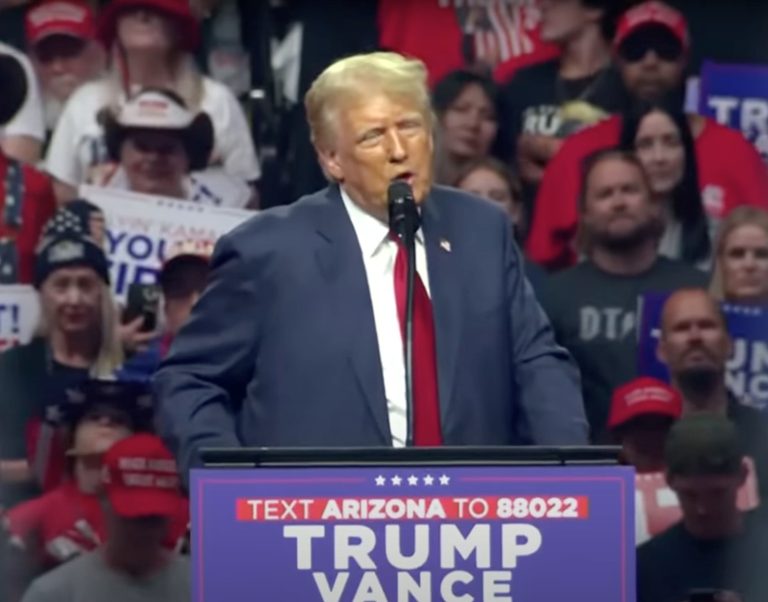
Many progressives have emphasized the stakes of this election on climate change, arguing that one of the major presidential candidates' agendas is better on the issue. That's true, except the Republican nominee will reduce more carbon pollution. [emphasis, links added]
While Democratic candidates support extreme climate policies, Former President Trump's energy-dominated agenda would cut government red tape, hold China accountable for its pollution and promote cleaner U.S. manufacturing.
A common-sense approach to energy policy will make America stronger and more secure while reducing carbon emissions.
Yet Vice President Kamala Harris supports the far left’s worst climate plans.
She was an early co-sponsor of the $93 trillion Green New Deal and called for a ban on fracking, Although this is the main reason why the United States leads the world in reducing emissions.
Now that Ms. Harris is the Democratic nominee, she has conveniently turned to fracking. She has not yet elaborated on how the Harris White House will address climate change.
She will likely continue the same chaotic policies of the Democratic Party. The Biden-Harris administration’s most important climate “achievement” is passage of the Inflation Reduction Act, More than $1 trillion will be spent to combat climate change.
However, unless the federal permitting reforms are signed into law, the legislation will not achieve the 80% of its projected emissions reductions, which this White House has failed to achieve.
Spending a lot of money on climate change is very inefficient because Most of the law's green subsidies would go to clean energy projects that would have been built anyway.
The administration is also suspending approval of new U.S. LNG export terminals in the name of helping the climate.
However, U.S. natural gas exports displace the use of more emissive natural gas and coal abroad, thereby reducing global emissions.
The administration caters to far-left environmentalists who are more concerned with curbing U.S. natural gas supplies than cutting emissions.
Cutting government red tape and empowering American producers is exactly what Trump’s energy-dominated agenda does well. A second Trump term would mean more domestic oil and gas, produced here in a cleaner way than in many other countries.
But energy dominance extends to all forms of energy. Our economy and competitive markets are great at making all energy more affordable, but burdensome regulations can get in the way.
The former president has no patience for red tape that limits America's advantages. Signing sweeping federal permitting reform, or at least using his executive authority to remove obstacles, would accelerate the construction of various energy infrastructure and increase the domestic mining industry.
The biggest obstacle to deploying clean energy in this country and outcompeting China is regulations, not Republicans.
Winning the clean energy arms race with China is critical to supporting American manufacturers and safeguarding U.S. energy security. We don’t want to rely on our competitors to power our homes or cars.
Winning this arms race would also significantly reduce global carbon dioxide pollution, as producers in places like Ohio and Kentucky would displace higher-emitting competitors from China and elsewhere.
The U.S. economy is three times more carbon efficient than China, but U.S. producers are not rewarded. At the same time, China ranks first in emissions in the world but is evading responsibility. This must change.
China has much worse environmental standards than the United States and profits from slave labor.
The next Trump administration should condemn all unfair practices by China. Carbon tariffs, for example, would punish China for its climate indifference and promote the development of lower-emitting U.S. producers.
Cutting government red tape and dealing with China's pollution problems will lead to a surge in U.S. manufacturing. A surge in U.S. manufacturing will bring profound climate benefits.
For example, the U.S. steel industry is 320% more carbon efficient than foreign steel industries. Our chemical manufacturers are 40% more efficient.
Thin-film solar panels made in the United States have 90% lower lifecycle emissions than silicon-based solar panels made in China.
Former President Trump has proven that energy dominance and reducing emissions are not mutually exclusive.
Even before the pandemic, U.S. carbon dioxide emissions had declined during his tenure. By comparison, emissions under Biden remain higher than those he inherited from Trump.
A second Trump term would cut red tape, challenge Chinese deception and spur U.S. manufacturing to reduce emissions even more than the Harris administration, which relies on subsidies and regulations, could.
Read more in The Washington Times
